
Homemade Salted Caramel Sauce
Super easy, homemade salted caramel sauce for drizzling on top of desserts or using in recipes!
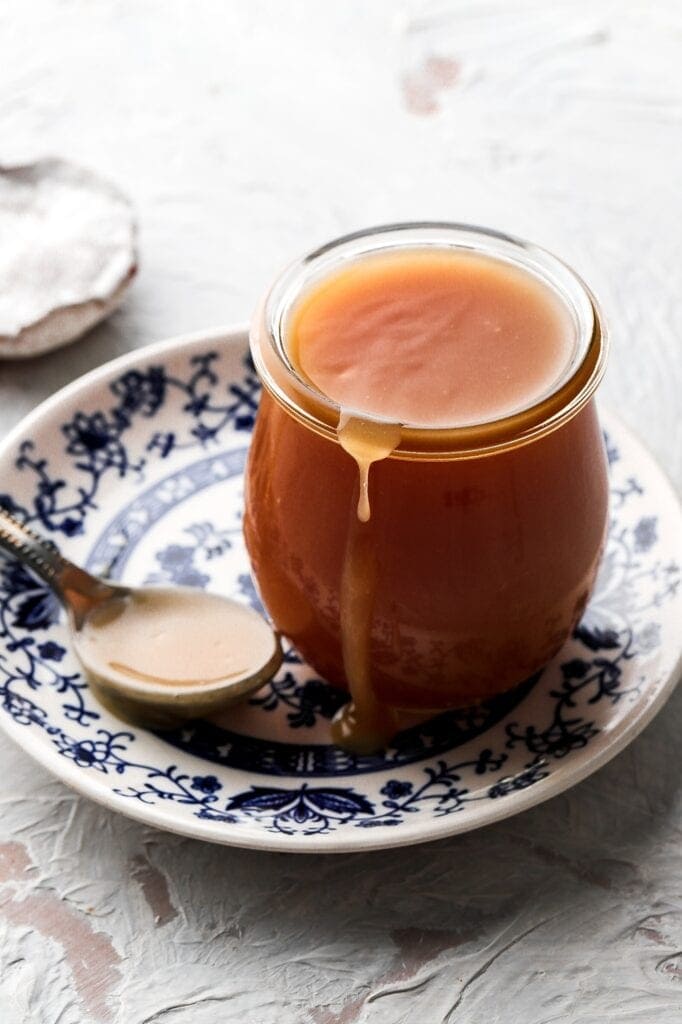
Hello, my friends! If you’ve ever looked through any of my recipes you’d probably notice that a lot of them use salted caramel sauce. I always prefer to make my caramel homemade because it is 1000x better tasting than any store bought caramel I’ve ever tried.
[adthrive-in-post-video-player video-id=”jemABV1k” upload-date=”2022-09-22T13:54:15.000Z” name=”Homemade Salted Caramel Sauce” description=”The absolute best homemade salted caramel sauce. A foolproof recipe with troubleshooting tips. ” player-type=”default” override-embed=”default”]How to make salted caramel sauce
So I’m not going to sugar coat it, caramel sauce seems pretty simple to make but it can be intimidating. It requires both patience and speed. There’s a science to everything in the kitchen and caramel is no exception. If you look around at some of the other caramel recipes online, you’ll notice that there are a few different ways to make it.
The basics steps for making caramel is carmelizing the sugar until it’s a nice amber color and then adding the butter and cream. For this recipe, I carmelize the sugar in a little bit of water without touching it at all and then once you add the butter and cream, you’ll stir it continuously, until it’s smooth.


The dry method
Many recipes will require you to place the granulated sugar over heat, stirring either constantly or intermittently until the sugar dissolves. It goes through a clumping stage and then melts and caramelizes. I have found success with this method at times but I’ve also found it to be a little risky.
With this method, you risk the sugar heating unevenly so some parts may brown/caramelize before other parts are not even melted. Stirring frequently will help with this however when you’re constantly touching it, you risk crystalizing the sugar (more on that later).
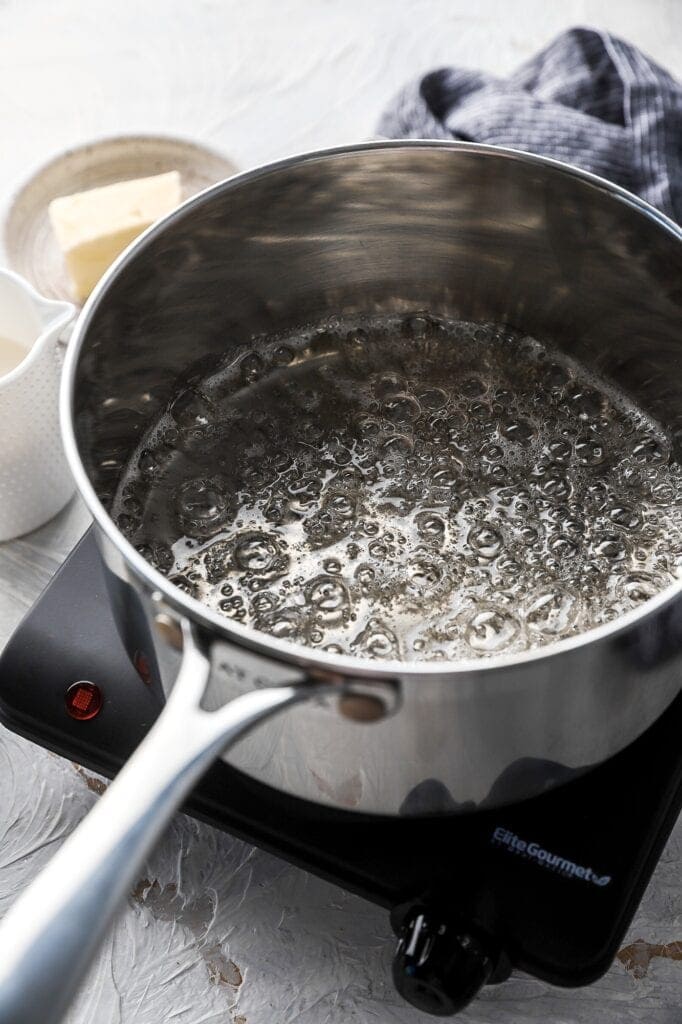
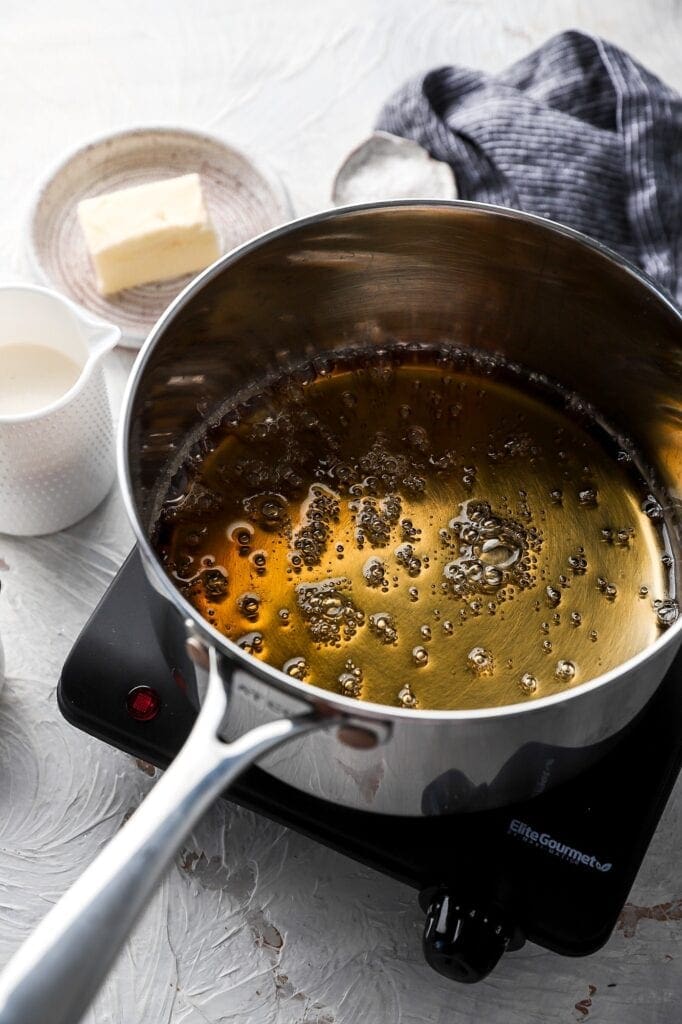
The wet method
This is the method I prefer to use. It requires dissolving the sugar in water before it carmelizes, so that the sugar heats up evenly. The amount of water is pretty insignificant since it gets boiled out anyway, the only difference is the more water you add, the more time it requires to evaporate.
It is also possible for the sugar to crystallize in this method. Specifically, at the point when most of the water has evaporated and the sugar is at a high temperature.
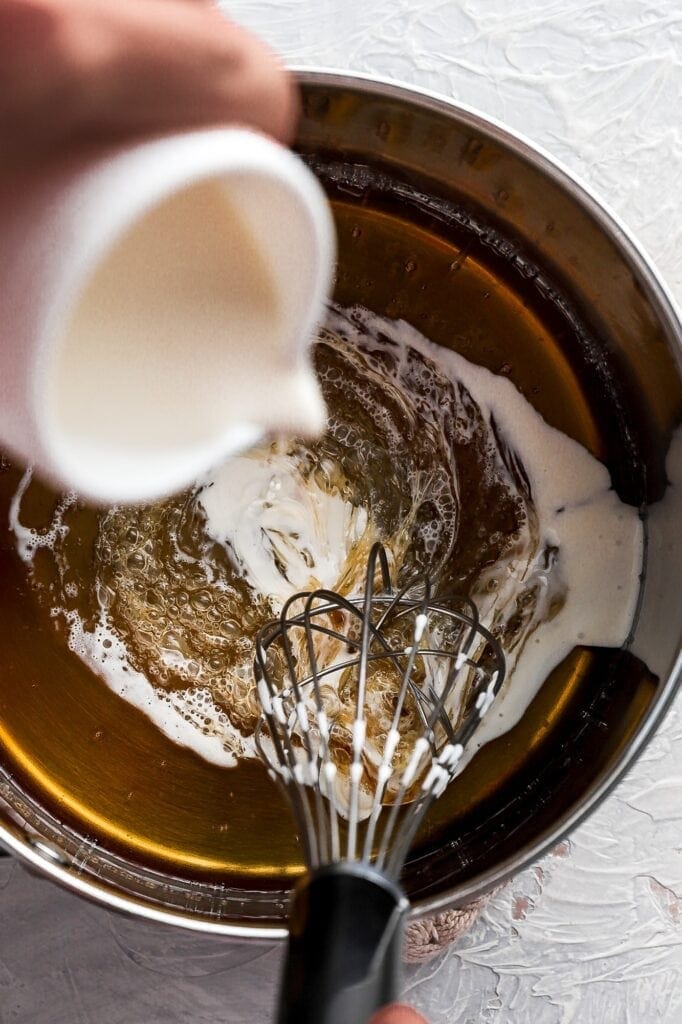

Why does sugar crystalize
Sugar at it’s solid state is crystalized and that’s the way it prefers to be. So whenever it gets the chance, aka, when the water evaporates in the wet method, the sugar molecules bind together forming a larger molecule that becomes insoluble in water.
Once a sugar molecule does crystalize, it makes it really easy for the rest of them to build up and crystallize on top of that. If the sugar does crystalize, it will no longer give you that silky smooth caramel you are looking for but there are ways to prevent this from happening.

How to prevent crystallization of sugar
The easiest method is by introducing another agent that will inhibit the sugar from binding together. Some things you can add are lemon juice, vinegar, corn syrup or glucose syrup. These molecules get between the sugar molecules so they don’t bind together.
I don’t usually find the need to add anything to my sugar while it’s caramelizing because I’ve found it to be very beneficial if I place the lid on top of my pan while the sugar and water are cooking. This way the steam that rises up hits the lid and then falls back down and washes away any crystalized sugar molecules from the edge of the pan. Remove the lid when it starts to brown a little and then we’re golden.
How to fix crystalized sugar
Luckily this is a super easy fix! To turn the crystalized sugar back into a smooth sugar syrup, all you need to do is add more water and restart the process. Add enough water to cover the sugar and then slowly heat it up again until the sugar dissolves.
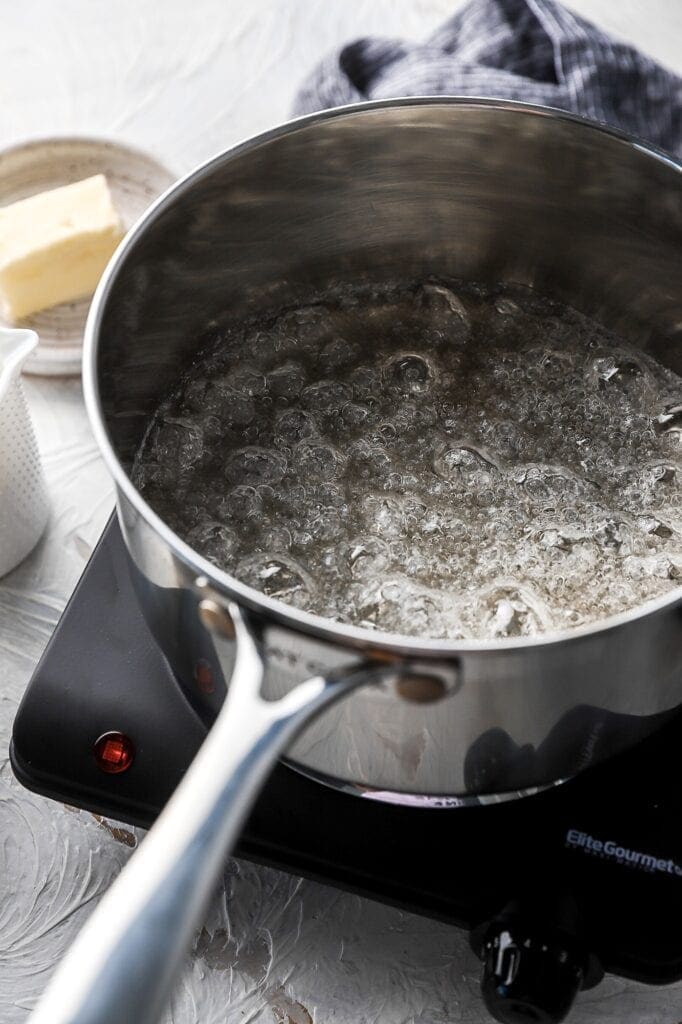
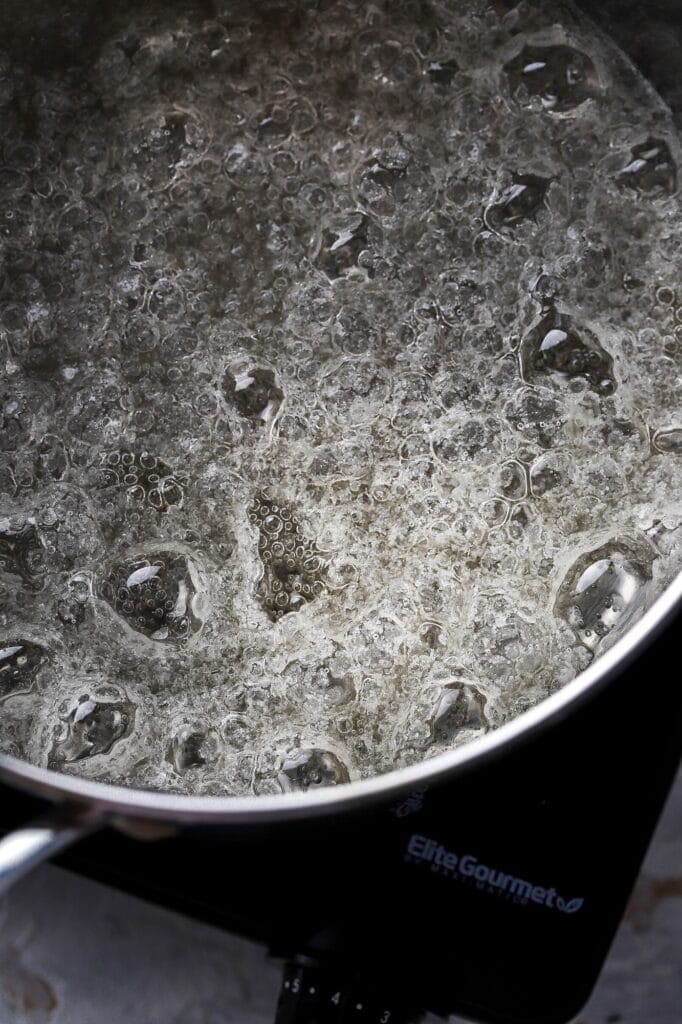
Getting the right consistency for caramel
The texture that I like for caramel sauce is to be thick and drizzly at room temperature. To get this texture, I carmelize my sugar until it’s that nice amber color, then I remove it from the heat and add the cream and butter. At this point I don’t return it to the heat because this gives me the consistency I’m looking for.
If you want it to be thicker, you can return it to the heat and continue to boil the liquid out a little. This will make a thicker, chewy caramel. If you want a thinner caramel, you can use milk instead of cream or add a little more cream or water. You can add more water or re-cook the caramel sauce after it’s done to change the consistency.
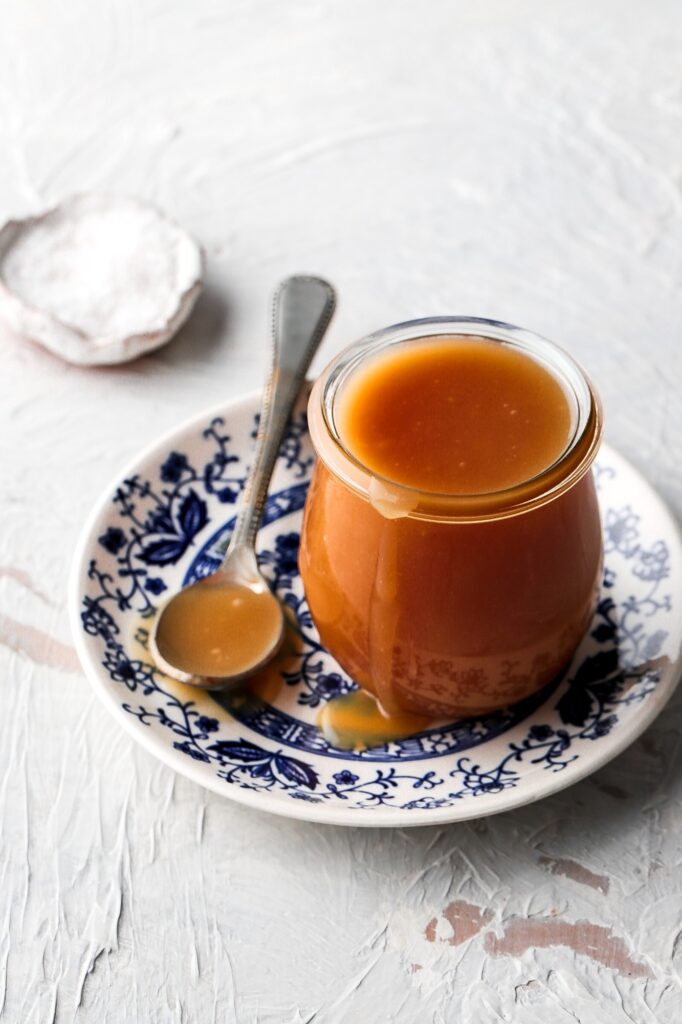
Storing and reheating caramel
I recommend storing the salted caramel sauce in the fridge, in an airtight container or mason jar. It should be good for at least two weeks, if not more. To reheat it, I microwave it for 15 second, 2-3x, stirring in between until it’s soft again. You can also place it over low heat on the stove top.
What to use salted caramel sauce on
Where do I start?! I could link like half my blog here hahah. I’ll just share my favorite recipes that use this recipe that give you a nice variety.
Alright, I hope that was detailed enough to troubleshoot all of your homemade caramel sauce problems. If you have any questions at all, leave a comment below and make sure to leave it in the comment section because I can’t respond to the rating section.
If you love this caramel sauce, please leave a 5 star review and if not then please leave a comment letting me know why!
As always, have a blessed day and happy baking!
Love, B


So for the first try I looked away a little longer than I should have and had smoke billowing from the pan. I took it outside and poured it on a couple weeds that needed to go. The second try I stayed vigilant. But I think maybe I didn’t let it get amber enough. So like you said in your tips, I put it back on the heat after I stirred in the cream and butter to boil off more water. It turned out Great 😃
Cooking is just like a science experiment anyway isn’t it. This was fun and delicious.
Thank You!!!
So glad it ended up working out, thank you for the review! 🙂
The BEST caramel! Low and slow and it comes out perfectly!
Came out perfectly and yummy, with an electric stove I kept the heat on 1 as opposed to “Low”, in 10 minutes it was a perfect amber color. A little trick when adding the cream, if you heat it in the microwave for 1 minute on 50% power to 165 degrees, it doesn’t bubble up as much and is much easier to whisk in.
I tried this caramel today, and ended up so frustrated! I followed everything to a T, and yet my caramel WOULD NOT turn an amber color! It did not crystalize either. After about half an hour, I increased the heat again, let it simmer for a bit, and then finished making it. Although it isn’t extremely delicious or caramel-y, it will work for my purposes. Any pointers for in the future?
Also followed the instructions exactly and it never turned an amber color. It looks like snot.
Followed your recipe exactly but could not get an amber color. Frustrating!
Hi Jan, how long did you heat the cook the sugar for? Did it crystallize at all?
hey, i was wondering why did my carmel have crunchy bits in it with the smooth carmel??
Hi, it can crystallize on the sides of the pan. I use a lid so the steam runs them down the sides of the pan or a wet pastry brush to brush them away. You can also add a tiny bit of vinegar or lemon juice to prevent it from crystalizing.
Can I use salted butter instead of unsalted butter for the caramel sauce?
Yes! I actually started using salted butter as well so I’ll update that 🙂
Thank you so much for your quick response! Made my first salted caramel sauce and it is delicious!!
This is so good! I drizzle it over ice cream or pie, or just eat it off a spoon! Excellent recipe! Thanks so much for sharing 😊
Hi,
if I want to try making it with dry method, do I just leave out the water completely or do I substitute the amount of water with cream?
Hi Linda, I would follow another recipe that uses that method 🙂